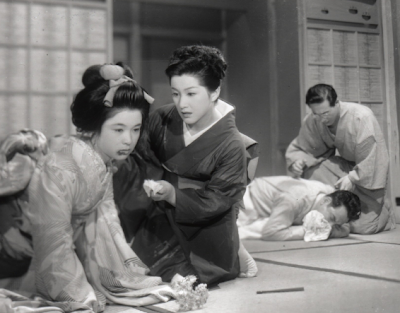
祇園の姉妹 (Gion no shimai)
Released: 1936
Director:
Kenji Mizoguchi
Starring:
Isuzu Yamada
Yôko Umemura
Benkei Shiganoya
Eitarô Shindô
Taizô Fukami
Running time: 96 min.
Reviewed by Matthew Hardstaff
Whether certain ideas had gestated in Kenji Mizoguchi’s head for quite sometime, inspired by art and literature, or whether his social ideals mirrored those of reformists of the era, attacking the institutions of the Geisha and organized prostitution, it wasn’t really until the double tap of "Osaka Elegy" and "Sisters of the Gion" that he really established himself as an artist expressing his social conscience through cinema.
"Sisters of Gion" tells the tale of two sisters, both geisha, who live in Kyoto’s pleasure district of Gion. Umekichi, played by Yoko Umemura, is the old sister, steeped in tradition and formality. She’s demure and reserved, representative of the waning feudal traditions, and the polar opposite of her younger sister Omocha who is modern, independent and socially dynamic. Isuzu Yamada, who played the refined and reserved type in "Osaka Elegy", shifts it into high gear, giving Omocha a defiant, bordering on arrogant, portrayal of a geisha who uses men as her play things, injecting no more feeling into the relationship than she has too. When Umekichi’s patron goes bankrupt, and breaks all ties with his family, she allows him to stay with her, for she forms real feelings for her clients. Shimbei Furusawa, the patron, becomes a thorn in Omocha’s side, so she begins to weave a web of deceit to convince him to leave. At the same time she searches for her own patron, and takes advantage of a clerk from a kimono shop. She plays with men like toys, while her sister struggles with the sudden departure of Shimbei. But it’s only a matter of time before Omocha’s lies come back to haunt her.
 If "Osaka Elegy" was the writing of the hypothesis for this socially conscious voice, then "Sister of the Gion" is the first proper experiment. Using the same crew and much of the same cast, "Osaka Elegy" and "Sisters of the Gion" where both released in 1936. "Osaka Elegy" laid the ground rules, established the themes and idea’s he wanted to explore, but with "Sisters of the Gion" he uses the narrative structure to explore and question. The parallel structure between the two sisters allows Mizoguchi to parallel the young and the old, the traditional and the modern, and represent the characters as women, regardless of their social status. They become more universal the more specific they become. Mizoguchi has been called a feminist, and that’s true I guess, in very loose terms. He explores the plight of women as brought on by society, but I think primarily he’s interested in how society’s norms create negative effects on all people. And he does so here with devastating effect. "Osaka Elegy" ended left you feeling sad for Ayako, but "Sisters of the Gion" left me depressed and angry!
If "Osaka Elegy" was the writing of the hypothesis for this socially conscious voice, then "Sister of the Gion" is the first proper experiment. Using the same crew and much of the same cast, "Osaka Elegy" and "Sisters of the Gion" where both released in 1936. "Osaka Elegy" laid the ground rules, established the themes and idea’s he wanted to explore, but with "Sisters of the Gion" he uses the narrative structure to explore and question. The parallel structure between the two sisters allows Mizoguchi to parallel the young and the old, the traditional and the modern, and represent the characters as women, regardless of their social status. They become more universal the more specific they become. Mizoguchi has been called a feminist, and that’s true I guess, in very loose terms. He explores the plight of women as brought on by society, but I think primarily he’s interested in how society’s norms create negative effects on all people. And he does so here with devastating effect. "Osaka Elegy" ended left you feeling sad for Ayako, but "Sisters of the Gion" left me depressed and angry!The film is an early masterpiece, but it’s still rough around the edges. It’s filled with long tracking shots and a beautiful use of staging and depth. By now Mizoguchi is able to fill each frame with so much visual information that long takes are visually a thing of beauty. It still doesn’t have the same level of perfectionism that would rise later in his career, some of the transitions are a little jarring, and the tracking shots aren’t nearly as complex as they eventually become, but its still exudes that same aura of cinematic mastery that most of his films have. Nothing is wasted or superfluous. Everything is methodically thought out and calculated to dramatic effect. It’s a short journey through the streets of Gion, but by the end you’ll know what it felt like to be a geisha on those very streets.
Read more by Matthew Hardstaff at his blog.


























2 comments:
Excellent review, I'm seeking this out right now.
Doesn't that black and white pic belong to another Mizoguchi film?
Post a Comment